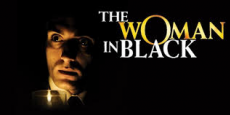
On the 22nd March 2016 I went to see “The Woman In Black” at the Fortune Theatre. The performance followed the haunted story of an old man named Arthur Kipps (Malcom James) who hires an actor (Matt Connor) to tell the tale of his encounter with the ‘woman in black’ at Eel Marsh House. This two hander (with a twist) was in the style of poor theatre, whereby the actors rely on suspension of disbelief from the audience and do not hide how things happen. During the performance, there were a great deal of atmosphere changes which had a very impressive effect on me as an audience member.
A particular moment when the audience felt an overwhelming atmosphere of tension was when there was a large chair, which was rocking back and forth slowly behind a see through curtain on stage. The actor gradually walked towards the chair, stepping cautiously across the stage from down stage right to downstage left and staring at the chair with wide open eyes and raised eyebrows. The eery atmosphere was successfully created by his naturalistic acting, where he did not have a melodramatic response, but was more left speechless by such a phenomenal situation. The curtain created a barrier between the audience and the actor, which added to the tension by creating a sense of isolation and alienation for the audience, a technique often used to conjure heightened feelings of fear and anticipation. This feeling was present throughout almost the entire performance, but built on during certain moments.
Another extremely effective moment which incited an awestruck atmosphere was when the “woman in black” came on stage and Connor stumbled backward in shock. His eyebrows quickly raise and his eyes widen, and his entire body becomes momentarily tense. He then tries to compose himself by regaining his posture and relaxing his facial muscles in to a determined, stern look. He is so strongly captivated by her that he can barely look away and when he turns, he leaves his eyes on her in awe, and then slowly drifts his vision away. This adds to an aura of amazement among the audience because she is so rarely seen that the audience are left in constant suspense, making it all the more exciting when she is seen on stage. The lack of speech in this scene made it particularly effective because it relied on the audience intently watching the actions happening on stage, and drew all attention to them. Also, due to the idea used throughout of building suspense, followed by a sudden shock, the audience were left waiting a long time wondering when the shock would be, heightening the sense of fear among them.
In contrast to the suspense and fear felt generally by the audience throughout the play, there were comedic moments. For example, at the beginning of the play, Kipps is reading out the extract from his diary, and the actor corrects him with mocking undertones. Kipps then goes on to attempt the performance again, but does not change his performance from the first time. He had hunched posture, lowered eyeline and placed his feet together. He sporadically and awkwardly looked up towards the ‘audience’ as he read the lines “It was nine-thirty on christmas eve”. Kipps mumbled the words quietly and quickly, in a monotonous voice and stuttered slightly on the word “nine”. These worked together to serve the purpose of making him seem timid and afraid. This was effective in entertaining the audience because he was totally unable to act upon the advice given by the young actor, emphasising his incompetence. The repetition of the lines reinforced the humour. As well as this, the actor said lines such as
In conclusion, there were many moments which incited a response from the audience and created heightened atmospheres. These were successfully performed by the actors on stage to, usually, create a tense and scary atmosphere, although there were a few humorous moments. I really enjoyed the performance and would urge anyone who can to go and experience it!

0 Comment:
Be the first one to comment on this article.